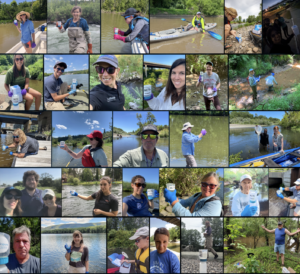In our June newsletter, we discussed water quality testing our staff participated in through Waterkeeper Alliance to learn whether we had PFAS compounds present in our watershed. Our results returned! We have detected some PFAS compounds in wastewater discharge to the river. Fortunately, concentrations are low however the results highlight the need for more testing.
Results
The location we tested was a small flow from a gravel pit where Healdsburg discharges wastewater downstream of the town. We believed, based on the lack of facilities that used PFAS in the watershed that this was the most likely source. Wastewater discharges are a common source because of PFAS-containing items in our homes mentioned above. The test results from upstream of the discharge point did not detect any PFAS compounds which is very positive. This means unlike more industrial areas in the Eastern US we don’t have PFAS throughout our watershed. The results from the wastewater discharge area showed relatively low concentrations for four of the five PFAS compounds tested. This tells us that we do have sources of PFAS contamination although below the levels that would pose a major threat to drinking water or the ecosystem.
What are PFAS?
Per- and polyfluoroalkyl substances (PFAS) are a class of manufactured organic chemicals that are pervasive in the environment and are linked to harmful public health and ecosystem impacts.
Health risks from PFAS exposure include increased risks of:
- cancer
- liver and kidney disease
- reproductive issues
- immunodeficiencies
- hormonal disruptions
Widely used in manufacturing since at least the 1950s, and incorporated into many industrial and common consumer products such as non-stick cooking pans, food packaging, and water- and stain-resistant clothing, PFAS are often referred to as “forever chemicals.” They are biopersistent, meaning they remain in organisms indefinitely without breaking down, and are bioaccumulative, meaning that over time, they build up in ever-increasing amounts in people, wildlife, aquatic life, and the environment.
Our Next Steps
We plan to conduct follow-up testing in other parts of the river and of drinking water sources both from the river and groundwater. This will help more definitively answer the question of whether we have a health risk from PFAS compounds in our watershed. In the meantime, Russian Riverkeeper, California Coastkeeper Alliance, and our global partners within the Waterkeeper Alliance will be advocating for phasing out all PFAS chemicals in use today. In addition, we’ll be advocating for resources to better understand the health implications of PFAS compounds so more protective water quality standards can be developed. This will better ensure our communities and the environment are protected.
You can take action in your homes and businesses by avoiding the use of items that contain PFAS compounds and making informed decisions about purchasing products that might contain PFAS. We can all be part of the solution by taking action in our homes which is where most of the PFAS in Healdsburg and other wastewater sources originate from.
Big shoutout and thank you to our fellow Waterkeeper Alliance members who also participated in this great collection!


